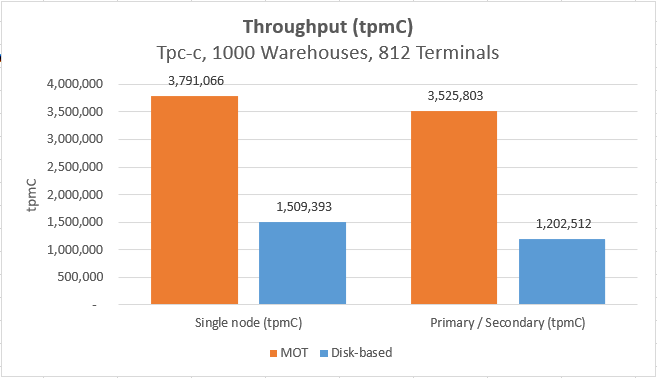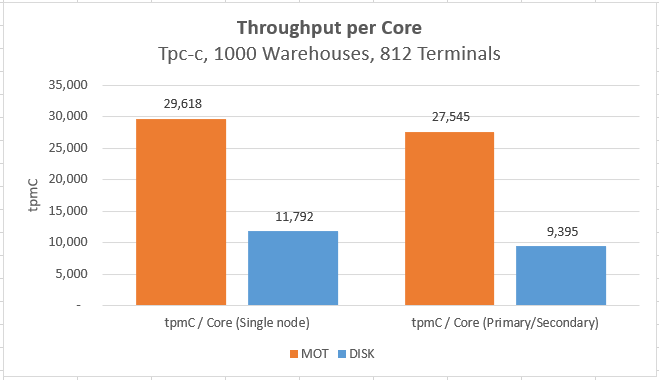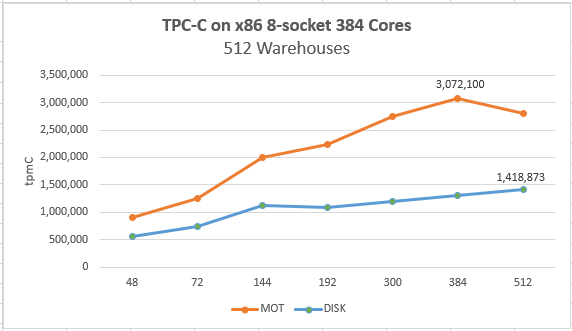MOT High Throughput
The following shows the results of various MOT table high throughput tests.
ARM/Kunpeng 2-Socket 128 Cores
Performance
The following figure shows the results of testing the TPC-C benchmark on a Huawei ARM/Kunpeng server that has two sockets and 128 cores.
Four types of tests were performed –
- Two tests were performed on MOT tables and another two tests were performed on openGauss disk-based tables.
- Two of the tests were performed on a Single node (without high availability), meaning that no replication was performed to a secondary node. The other two tests were performed on Primary/Secondary nodes (with high availability), meaning that data written to the primary node was replicated to a secondary node.
MOT tables are represented in orange and disk-based tables are represented in blue.
Figure 1 ARM/Kunpeng 2-Socket 128 Cores – Performance Benchmarks
The results showed that:
- As expected, the performance of MOT tables is significantly greater than of disk-based tables in all cases.
- For a Single Node – 3.8M tpmC for MOT tables versus 1.5M tpmC for disk-based tables
- For a Primary/Secondary Node – 3.5M tpmC for MOT tables versus 1.2M tpmC for disk-based tables
- For production grade (high-availability) servers (Primary/Secondary Node) that require replication, the benefit of using MOT tables is even more significant than for a Single Node (without high-availability, meaning no replication).
- The MOT replication overhead of a Primary/Secondary High Availability scenario is 7% on ARM/Kunpeng and 2% on x86 servers, as opposed to the overhead of disk tables of 20% on ARM/Kunpeng and 15% on x86 servers.
Performance per CPU core
The following figure shows the TPC-C benchmark performance/throughput results per core of the tests performed on a Huawei ARM/Kunpeng server that has two sockets and 128 cores. The same four types of tests were performed (as described above).
Figure 2 ARM/Kunpeng 2-Socket 128 Cores – Performance per Core Benchmarks
The results showed that as expected, the performance of MOT tables is significantly greater per core than of disk-based tables in all cases. It also shows that for production grade (high-availability) servers (Primary/Secondary Node) that require replication, the benefit of using MOT tables is even more significant than for a Single Node (without high-availability, meaning no replication).
ARM/Kunpeng 4-Socket 256 Cores
The following demonstrates MOT's excellent concurrency control performance by showing the tpmC per quantity of connections.
Figure 3 ARM/Kunpeng 4-Socket 256 Cores – Performance Benchmarks
The results show that performance increases significantly even when there are many cores and that peak performance of 4.8M tpmC is achieved at 768 connections.
x86-based Servers
- 8-Socket 384 Cores
The following demonstrates MOT’s excellent concurrency control performance by comparing the tpmC per quantity of connections between disk-based tables and MOT. This test was performed on an X86 server with eight sockets and 384 cores. The orange represents the results of the MOT table.
Figure 4 x86 8-Socket 384 Cores – Performance Benchmarks
The results show that MOT tables significantly outperform disk-based tables and have very highly efficient performance per core on a 386 core server, reaching over 3M tpmC / core.
- 4-Socket 96 Cores
3.9 million tpmC was achieved by MOT on this 4-socket 96 cores server. The following figure shows a highly efficient MOT table performance per core reaching 40,000 tpmC / core.
